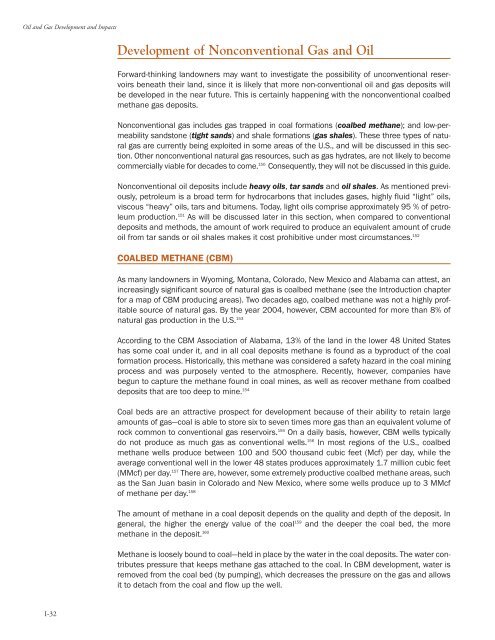Oil and Gas at Your Door? (2005 Edition) - Earthworks
Oil and Gas at Your Door? (2005 Edition) - Earthworks
Oil and Gas at Your Door? (2005 Edition) - Earthworks
Create successful ePaper yourself
Turn your PDF publications into a flip-book with our unique Google optimized e-Paper software.
<strong>Oil</strong> <strong>and</strong> <strong>Gas</strong> Development <strong>and</strong> Impacts<br />
Development of Nonconventional <strong>Gas</strong> <strong>and</strong> <strong>Oil</strong><br />
Forward-thinking l<strong>and</strong>owners may want to investig<strong>at</strong>e the possibility of unconventional reservoirs<br />
bene<strong>at</strong>h their l<strong>and</strong>, since it is likely th<strong>at</strong> more non-conventional oil <strong>and</strong> gas deposits will<br />
be developed in the near future. This is certainly happening with the nonconventional coalbed<br />
methane gas deposits.<br />
Nonconventional gas includes gas trapped in coal form<strong>at</strong>ions (coalbed methane); <strong>and</strong> low-permeability<br />
s<strong>and</strong>stone (tight s<strong>and</strong>s) <strong>and</strong> shale form<strong>at</strong>ions (gas shales). These three types of n<strong>at</strong>ural<br />
gas are currently being exploited in some areas of the U.S., <strong>and</strong> will be discussed in this section.<br />
Other nonconventional n<strong>at</strong>ural gas resources, such as gas hydr<strong>at</strong>es, are not likely to become<br />
commercially viable for decades to come. 150 Consequently, they will not be discussed in this guide.<br />
Nonconventional oil deposits include heavy oils, tar s<strong>and</strong>s <strong>and</strong> oil shales. As mentioned previously,<br />
petroleum is a broad term for hydrocarbons th<strong>at</strong> includes gases, highly fluid “light” oils,<br />
viscous “heavy” oils, tars <strong>and</strong> bitumens. Today, light oils comprise approxim<strong>at</strong>ely 95 % of petroleum<br />
production. 151 As will be discussed l<strong>at</strong>er in this section, when compared to conventional<br />
deposits <strong>and</strong> methods, the amount of work required to produce an equivalent amount of crude<br />
oil from tar s<strong>and</strong>s or oil shales makes it cost prohibitive under most circumstances. 152<br />
COALBED METHANE (CBM)<br />
As many l<strong>and</strong>owners in Wyoming, Montana, Colorado, New Mexico <strong>and</strong> Alabama can <strong>at</strong>test, an<br />
increasingly significant source of n<strong>at</strong>ural gas is coalbed methane (see the Introduction chapter<br />
for a map of CBM producing areas). Two decades ago, coalbed methane was not a highly profitable<br />
source of n<strong>at</strong>ural gas. By the year 2004, however, CBM accounted for more than 8% of<br />
n<strong>at</strong>ural gas production in the U.S. 153<br />
According to the CBM Associ<strong>at</strong>ion of Alabama, 13% of the l<strong>and</strong> in the lower 48 United St<strong>at</strong>es<br />
has some coal under it, <strong>and</strong> in all coal deposits methane is found as a byproduct of the coal<br />
form<strong>at</strong>ion process. Historically, this methane was considered a safety hazard in the coal mining<br />
process <strong>and</strong> was purposely vented to the <strong>at</strong>mosphere. Recently, however, companies have<br />
begun to capture the methane found in coal mines, as well as recover methane from coalbed<br />
deposits th<strong>at</strong> are too deep to mine. 154<br />
Coal beds are an <strong>at</strong>tractive prospect for development because of their ability to retain large<br />
amounts of gas—coal is able to store six to seven times more gas than an equivalent volume of<br />
rock common to conventional gas reservoirs. 155 On a daily basis, however, CBM wells typically<br />
do not produce as much gas as conventional wells. 156 In most regions of the U.S., coalbed<br />
methane wells produce between 100 <strong>and</strong> 500 thous<strong>and</strong> cubic feet (Mcf) per day, while the<br />
average conventional well in the lower 48 st<strong>at</strong>es produces approxim<strong>at</strong>ely 1.7 million cubic feet<br />
(MMcf) per day. 157 There are, however, some extremely productive coalbed methane areas, such<br />
as the San Juan basin in Colorado <strong>and</strong> New Mexico, where some wells produce up to 3 MMcf<br />
of methane per day. 158<br />
The amount of methane in a coal deposit depends on the quality <strong>and</strong> depth of the deposit. In<br />
general, the higher the energy value of the coal 159 <strong>and</strong> the deeper the coal bed, the more<br />
methane in the deposit. 160<br />
Methane is loosely bound to coal—held in place by the w<strong>at</strong>er in the coal deposits. The w<strong>at</strong>er contributes<br />
pressure th<strong>at</strong> keeps methane gas <strong>at</strong>tached to the coal. In CBM development, w<strong>at</strong>er is<br />
removed from the coal bed (by pumping), which decreases the pressure on the gas <strong>and</strong> allows<br />
it to detach from the coal <strong>and</strong> flow up the well.<br />
I-32




